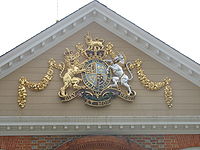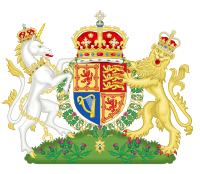- Royal coat of arms of the United Kingdom
-
Royal coat of arms of the United Kingdom of Great Britain and Northern Ireland 
Versions 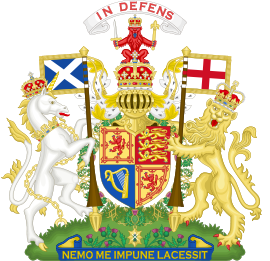
Royal coat of arms of the United Kingdom for use in ScotlandDetails Armiger Elizabeth II Adopted 1837 Crest A golden lion, royally crowned and standing on a royal crown; gold and ermine mantling Escutcheon Quarterly: 1 and 4 England, 2 Scotland, 3 Ireland; quarters for England and Scotland are exchanged in Scotland. Supporters A golden lion and a silver unicorn Compartment Tudor rose, Shamrock, and Thistle Motto French: Dieu et mon droit Orders Order of the Garter Earlier versions see below Use On all Acts of Parliament; the cover of all UK passports; various government departments; adapted for the reverse of coins of the pound sterling (2008) The Royal coat of arms of the United Kingdom is the official coat of arms of the British monarch, currently Queen Elizabeth II. These arms are used by the Queen in her official capacity as monarch of the United Kingdom, and are officially known as her Arms of Dominion. Variants of the Royal Arms are used by other members of the Royal Family; and by the British government in connection with the administration and government of the country. In Scotland, the Queen has a separate version of the Royal Arms, a variant of which is used by the Scotland Office.
The shield is quartered, depicting in the first and fourth quarters the three passant guardant lions of England; in the second, the rampant lion and double tressure flory-counterflory of Scotland; and in the third, a harp for Northern Ireland. The crest is a statant guardant lion wearing the imperial crown, himself on another representation of that crown. The dexter supporter is a likewise crowned English lion; the sinister, a Scottish unicorn. According to legend a free unicorn was considered a very dangerous beast; therefore the heraldic unicorn is chained,[1] as were both supporting unicorns in the Royal coat of arms of Scotland. The coat features both the motto of English monarchs, Dieu et mon droit (God and my right), and the motto of the Order of the Garter, Honi soit qui mal y pense (Shamed be he who thinks ill of it) on a representation of the Garter behind the shield.
The official blazon of the Royal Arms is:
- Quarterly, first and fourth Gules three lions passant gardant in pale Or armed and langued Azure (for England), second quarter Or a lion rampant within a double tressure flory-counter-flory Gules (for Scotland), third quarter Azure a harp Or stringed Argent (for Ireland), the whole surrounded by the Garter; for a Crest, upon the Royal helm the imperial crown Proper, thereon a lion statant gardant Or imperially crowned Proper; Mantling Or and ermine; for Supporters, dexter a lion rampant gardant Or crowned as the Crest, sinister a unicorn Argent armed, crined and unguled Proper, gorged with a coronet Or composed of crosses patée and fleurs de lis a chain affixed thereto passing between the forelegs and reflexed over the back also Or. Motto 'Dieu et mon Droit' in the compartment below the shield, with the Union rose, shamrock and thistle engrafted on the same stem.[2]
Contents
Uses
The Royal Arms as shown above may only be used by the Queen herself. They also appear in court rooms, since the monarch is the fount of justice in the UK and the law Court is part of the Court of the monarch (hence its name). Judges are officially representatives of the crown, demonstrated by the Queen's Coat of Arms which sits behind the judge on the wall of every court in the land, with the exceptions of the magistrates court in the City of London, in which a sword stands vertically behind the judge which is flanked by the arms of the City and the Crown. Also, in Northern Ireland, the Royal Arms must not be displayed in any courtroom, excepting the Royal Courts of Justice in Belfast, the courts in Armagh, Banbridge, Downpatrick, Magherafelt, or Omagh and on the exterior of an existing court where they were displayed immediately before 2002.[3]
The British Government also uses the Royal Coat of Arms as a national symbol of the United Kingdom, and, in that capacity, the Coat of Arms can be seen on several government documents and forms, passports, in the entrance to embassies and consulates, etc. However, when used by the government and not by the sovereign herself, the coat of arms is often represented without the helm. This is also the case with the sovereign's Scottish arms, a version of which is used by the Scotland Office.
The Royal Arms have regularly appeared on the coinage produced by the Royal Mint including, for example, from 1663, the Guinea and, from 1983, the British one pound coin. In 2008, a new series of designs for all seven coins of £1 and below was unveiled by the Royal Mint, every one of which is drawn from the Royal Arms. The full Royal Arms appear on the one pound coin, and sections appear on each of the other six, such that they can be put together like a puzzle to make another complete representation of the Royal Arms.[4]
The Queen awards Royal Warrants to various businesses that supply the Royal Household. This allows the business to display the Royal Arms on their packaging and stationery.
A banner of the arms, the Royal Standard is flown from the Royal Palaces when the Queen is in residence; and from public buildings only when the Queen is present. At royal residences such as Windsor Castle or Buckingham Palace, the Queen's main residence, the Royal Standard is flown to indicate when the monarch is in residence. This protocol equally applies to the monarch's principal residences in Scotland, (the Palace of Holyroodhouse and Balmoral Castle), where the Royal Standard as used in Scotland is flown. When the monarch is not in residence the Union Flag, or in Scotland the ancient Royal Standard of Scotland, is flown.
A design similar to The Royal Arms is also a symbol for all the courts in British Columbia, Canada, as the Commission under which judges sit within its courts' rooms.[5]
The royal arms is also used as a symbol for all the State courts and Viceroys of Australia to represent the power of the monarchy.
Scotland
Since the Union of the Crowns in 1603, a separate version of the royal arms has been used in Scotland, giving the Scottish elements pride of place.
The shield is quartered, depicting in the first and fourth quarters the lion rampant of Scotland; in the second, the three lions passant guardant of England; and in the third, the harp of Ireland.
The crest atop the Crown of Scotland is a red lion, seated and forward facing, itself wearing the Crown of Scotland and holding the two remaining elements of the Honours of Scotland, namely the Sword of State and the Sceptre of Scotland. This was also the crest used in the Royal Arms of the Kingdom of Scotland. The motto, in Scots, appears above the crest, in the tradition of Scottish heraldry, and is an abbreviated form of the full motto: In My Defens God Me Defend.
The supporters change sides and both appear wearing the crowns of their respective Kingdom. The dexter supporter is a crowned and chained unicorn, symbolising Scotland. The sinister supporter is a crowned lion, symbolising England. Between each supporter and the shield is a lance displaying the flag of their respective Kingdom.
The coat also features both the motto Nemo me impune lacessit (No one wounds (touches) me with impunity) and, surrounding the shield, the collar of the Order of the Thistle.
England, Wales and Northern Ireland
Unlike the Act of Union 1707 with Scotland, the Act of Union 1800 with Ireland did not provide for a separate Irish version of the royal arms. The crest of the Kingdom of Ireland (on a wreath Or and Azure, a tower triple-towered of the First, from the portal a hart springing Argent attired and unguled Or) has had little or no official use since the union. When the Irish Free State established its own seals in the 1930s, the "Fob Seal" used on letters of credence varied the British arms by having the harp in two quarters.[6]
The harp quarter of the Royal Arms represents Ireland on both the English and Scottish versions. Likewise, one English quarter is retained in the Scottish version, and one Scottish quarter is retained in the English version. Thus, England, Scotland and Ireland are represented in all versions of the Royal Arms since they came under one monarch. By contrast, there is no representation at all for Wales in the Royal Arms, as at the Act of Union 1707 Wales was an integral part of the Kingdom of England pursuant to the Laws in Wales Acts 1535-1542; thus, it can be argued Wales is represented in the English coat of arms. Wales was a kingdom when ruled by native Kings, some of whom united it under one Crown, but with the English conquest it largely ceased to exist as a distinct legal entity. The Prince of Wales has ever since been the monarch's heir apparent.
Upon the accession of the Tudor Kings and Queens, who were themselves of Welsh descent, a Welsh dragon was used as a supporter on the Royal Arms. This was dropped by their successors, the Scottish House of Stuart, who replaced the Tudors' dragon supporter with the Scottish unicorn.
In the twentieth century, the arms of the principality of Wales were added as an inescutcheon to the coat of arms of the Prince of Wales, and a banner of those arms with a green inescutcheon bearing the Prince's crown is flown as his personal standard in Wales. The so-called Prince of Wales's feathers are a heraldic badge rather than a coat of arms upon a shield, but they are not Welsh in any case. They derive, in fact, from the English Princes of Wales (who allegedly owe them to an exploit of Edward, the Black Prince at the Battle of Crécy) and carry a German motto ("Ich Dien", German for "I Serve"). In any event, they do not form part of the Royal Arms, as opposed to the heraldic achievement of the Prince of Wales, who drops them upon his accession as King.
History
Kingdoms of England and Scotland
The current Royal Arms are a combination of the arms of the kingdoms that make up the United Kingdom, and can be traced back to the first arms of the Kings of England and Kings of Scots. Various alterations occurred over the years as the arms of other realms acquired or claimed by the Kings were added to the Royal Arms. The table below tracks the changes in the Royal Arms from the original arms of King Richard I of England, and William I, King of Scots.
Kingdom of England Kingdom of Scotland Arms Dates Details 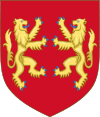
c. 1189 Possible interpretation of the arms shown on King Richard I's first Great Seal. These are the arms of Plantagenet, of which family Richard was a member. The tinctures and the number of charges shown in this illustration are speculative. 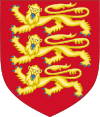
1198-1340
1360-1369The arms on the second Great Seal of King Richard I "The Lionheart", used by his successors until 1340: three golden lions passant gardant (or "leopards"), on a red field.[2] 
1340-1360
1369-1395
1399-1406King Edward III quartered the Royal Arms of England with the ancient arms of France, the fleurs-de-lis on a blue field, to signal his claim to the French throne.[2] 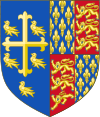
1395–1399 King Richard II impaled the Royal Arms of England with the arms attributed to King Edward the Confessor.[2] 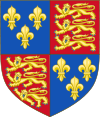
1406–1422 King Henry IV updated the French arms to the modern version, three fleurs-de-lis on a blue field.[2] 
1422-1461
1470-1471King Henry VI impaled the French and English arms, using the same arms after his "readeption".[1] 
1461-1470
1471-1554King Edward IV restored the arms of King Henry IV. 
1554–1558 Queen Mary I impaled her arms with those of her husband, King Philip.[2] Although Queen Mary I's father, King Henry VIII, assumed the title "King of Ireland" and this was further conferred upon King Philip, the arms were not altered to feature the Kingdom of Ireland. 
1558–1603 Queen Elizabeth I restored the arms of King Henry IV.[2] Arms Dates Details 
12th century - 1558 A red lion, rampant, on a yellow field within a double royal tressure, flory counter-flory, first used by King William I, and later by his successors, and becoming the heraldic representation of Scotland. 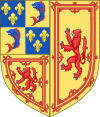
1558–1559 Mary, Queen of Scots, impaled with the arms of Francis, Dauphin of France, King consort of Scots.[7] 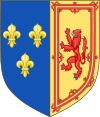
1559–1560 Mary, Queen of Scots and Queen consort of France. 
1560–1565 Mary, Queen of Scots and Queen dowager of France. 
1565–1603 Upon her (second) marriage to Henry Stuart, Lord Darnley in 1565, Mary discontinued the arms of Scotland and France impaled, reverting to those of the Kingdom of Scotland.[8] King James VI was the last monarch of Scotland to use these arms prior to the Union of the Crowns in 1603. Union and Commonwealth
The Union of the Crowns places England, Ireland and Scotland under one monarch Arms Dates Details 

1603–1649 James VI, King of Scots inherited the English and Irish thrones in 1603 (Union of the Crowns), and quartered the Royal Arms of England with those of Scotland. For the first time, the Royal Coat of Arms of Ireland was added to represent the Kingdom of Ireland.[2] (The Scottish version differs in giving the Scottish elements more precedence.) 
1649–1654 English Interregnum These novel arms, already in use by parliamentarians in 1648, were adopted by the Commonwealth of England established in 1649.[9]

1654–1655 The Commonwealth of England, Scotland and Ireland (the Protectorate) was created in 1653. St Andrew's Cross was added to the arms in 1654.[10]
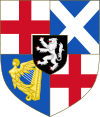
1655–1660 The Great Seal struck in 1655[9] displayed new Arms of the Commonwealth, including the personal arms Oliver Cromwell on a shield in the centre.[2] Blazon: Quarterly 1 and 4 Argent a Cross Gules (England) 2 Azure a Saltire Argent (Scotland) and 3 Azure a Harp Or Stringed Argent (Ireland) on an Inescutcheon Sable a Lion Rampant Argent (Cromwell's arms). The supporters were a crowned lion of England and a red dragon of Wales. The Scottish unicorn was removed, as it was associated with the Stewart Monarchy. The motto read PAX QUÆRITUR BELLO ("peace is obtained through war").[11]


Charles II restored the Royal Arms following the restoration after the civil wars. 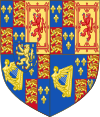

1689–1694 King James II & VII is deposed and replaced with his daughter Mary and her husband, William, Prince of Orange ruling jointly as William III & II and Mary II. As King and Queen Regnant they impaled their arms: William bore the Royal Arms with an escutcheon of Nassau (the royal house to which William belonged) added (a golden lion rampant on a blue field), while Mary bore the Royal Arms undifferenced.[12][13] 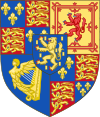
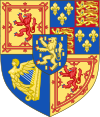
1694–1702 After the death of Mary II, William III reigned alone, and used his arms only.[2][12] 

1702–1707 Queen Anne inherited the throne upon the death of King William III & II, and the Royal Arms returned to the 1603 version.[2] 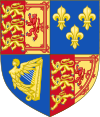
1707–1714 The Acts of Union 1707 created the Kingdom of Great Britain (1707–1800). The Royal Arms of England and Scotland are impaled and moved to the first and fourth quarters, France second quarter and Ireland third quarter.[2] 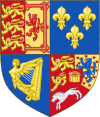
1714–1800 The Elector of Hanover inherited the throne following the death of Queen Anne under the provisions of the Act of Settlement 1701, becoming King George I. The fourth quarter of the arms was changed to reflect the new King's domains in Hanover (Brunswick–Lüneburg–Westphalia, surmounted by the Imperial Crown of the Holy Roman Empire for the Holy Roman office of Archbannerbearer/Archtreasurer).[2] 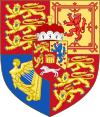
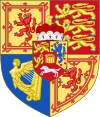
1801–1816 The Acts of Union 1800 united the Kingdoms of Great Britain and Ireland. At the same time, King George III abandoned his ancestors' ancient claim to the French throne. The Royal Arms changed, with England now occupying the first and fourth quarters, Scotland the second, Ireland the third. For the Electorate of Hanover, there is an inescutcheon surmounted by the electoral bonnet.[2] The Arms of Hanover were similar, but lacked the electoral bonnet. 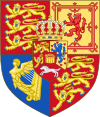
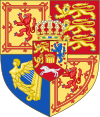
1816–1837 The electoral bonnet was replaced by a Royal Crown in 1816, as Hanover had been declared a kingdom two years previous.[2] 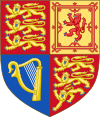
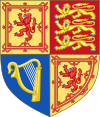
1837–present The accession of Queen Victoria ended the personal union between the UK and Hanover, as Salic law prevented a woman from ascending the Hanoverian throne. The escutcheon of Hanover was removed and the Royal Arms remained the same.[2] There was no attempt to alter the Royal Arms to reflect later titles acquired by the British monarch such as Emperor of India. The harp of the Kingdom of Ireland remains despite partition in 1921, to represent Northern Ireland (although it is most often seen today as a plain Gaelic harp, rather than a winged female [as above], in accordance with the personal preference of Queen Elizabeth).[14] The Royal Arms do not incorporate any specific element for Wales, a principality, incorporated into the Kingdom of England under Henry VIII. However, the Prince of Wales places arms for Wales at the centre of his personal arms. Other variants
Royal Family
Members of the British Royal Family receive their own personalised arms which are based on the Royal Arms. Only children and grandchildren in the male line of the monarch are entitled to receive their own arms in this fashion. The arms of children of the monarch are differentiated by a three point label; grandchildren of the monarch are differentiated by a five point label. An exception is made for the eldest son of the Prince of Wales, who received a three point label. Since 1911, the arms of the Prince of Wales also has an inescutcheon of the ancient arms of the Principality of Wales.
Queens consort and the wives of sons of the monarch also receive their own personalised coat of arms. Typically this will be the arms of their husband impaled with their own personal arms or those of their father. However, the consorts of a Queen regnant are not entitled to use the Royal Arms. Thus Prince Philip, Duke of Edinburgh uses his own personal arms.
Currently the following members of the Royal Family have their own arms based on the Royal Arms:
Children and grandchildren of the monarch in the male line Arms/Standard Bearer Difference 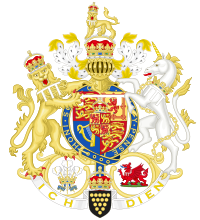
Charles, Prince of Wales Plain three-point label, and an inescutcheon of the traditional coat of arms of the Principality of Wales.[2] 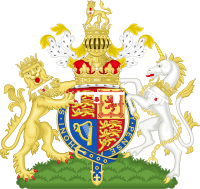
Prince William, Duke of Cambridge Three-point label with a red escallop, alluding to the arms of his mother, Diana, Princess of Wales.[15] 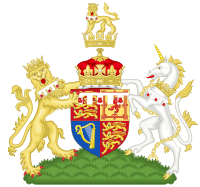
Prince Harry of Wales Five-point label with three red escallops in alternate points.[15] 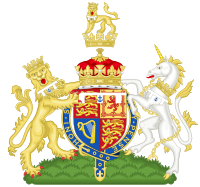
Prince Andrew, Duke of York Three-point label, the centre point bearing a blue anchor.[2] 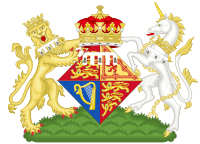
Princess Beatrice of York Five-point label with three Bees in alternate points. 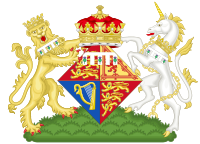
Princess Eugenie of York Five-point label with three Thistles in alternate points. 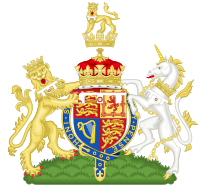
Prince Edward, Earl of Wessex Three-point label, the centre point bearing a Tudor rose. 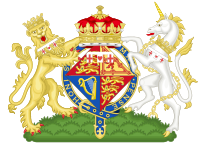
Anne, Princess Royal Three-point label, the points bearing a red cross, a red heart and a red cross.[2] 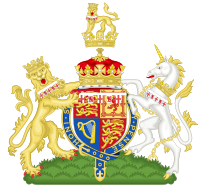
Prince Richard, Duke of Gloucester Five-point label, the first, third and fifth points bearing a red cross, the second and fourth points bearing a red lion.[2] 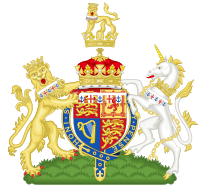
Prince Edward, Duke of Kent Five-point label, the first, third and fifth points bearing a blue anchor, the second and fourth points bearing a red cross.[2] 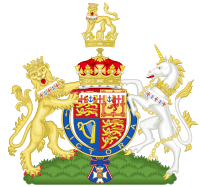
Prince Michael of Kent Five-point label, the first, third and fifth points bearing a red cross, the second and fourth points bearing a blue anchor.[2] 
Princess Alexandra, The Honourable Lady Ogilvy Five-point label, the first and fifth points bearing a red heart, the second and fourth points bearing a blue anchor, and the third bearing a red cross.[2] Consorts 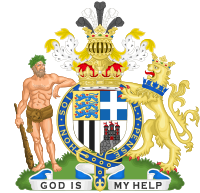
Prince Philip, Duke of Edinburgh Prince Philip was granted arms of his own in 1947, because men are not entitled to bear the arms of their wives. His arms are quarterly Denmark, Greece, and Mountbatten, representing his ancestry, and Edinburgh, representing his dukedom.[2] 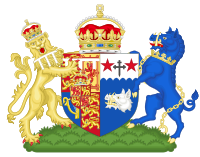
Camilla, Duchess of Cornwall The arms of the Prince of Wales impaled with those of her father, Major Bruce Shand, crowned by the single-arched Crown of Prince of Wales.[16] 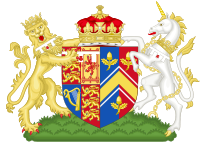
Catherine, Duchess of Cambridge The arms of the Duke of Cambridge impaled with those of her father, Mr Michael Middleton, crowned by the coronet of a child of the heir-apparent. 
Sophie, Countess of Wessex The arms of the Earl of Wessex impaled with those granted in 1999 to her father, Christopher Rhys-Jones, and his older brother Theo. The new grant was based on an unregistered 200 year-old design. The Lion alludes to one of the Countess' ancestors the Welsh warrior Elystan Glodrydd, Prince of Ferrig.[17] 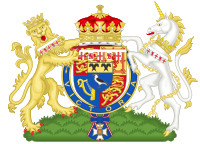
Birgitte, Duchess of Gloucester The arms of the Duke of Gloucester with the arms of her father, Asger Preben Wissing Henriksen, imposed in an inescutcheon at the centre. 
Katharine, Duchess of Kent The arms of the Duke of Kent impaled with those of her father, Sir William Arthington Worsley of Hovingham, 4th Baronet. 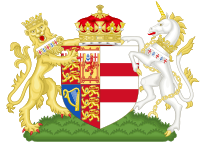
Princess Michael of Kent The arms of Prince Michael impaled with those of her father, Baron Günther Hubertus von Reibnitz. Government
Her Majesty's Government uses a version of the Royal Arms but without the helm or crest, as a result of which the crown sits atop the shield. In relation to Scotland, the Scotland Office uses the Scottish version, again without the helm or crest, and the same was used as the day-to-day logo of the Scottish Executive until September 2007, when a rebranding exercise introduced the name Scottish Government, together with a revised logo incorporating the flag of Scotland.[citation needed]
The Arms feature
- on all Acts of Parliament;
- on the cover of all UK passports; and
- as an inescutcheon on the diplomatic flags of British Ambassadors.
It is also used by the following government departments:
- The Foreign and Commonwealth Office
- HM Treasury
- Ministry of Justice
- Northern Ireland Office
- Scotland Office (Scottish version)
- Court of Session (Scottish version)
- The Supreme Court of Newfoundland and Labrador in Canada [2]
Furthermore:
- A version of the crest of the Royal Arms, as used in Scotland, is used by the Crown Office and Procurator Fiscal Service, the General Register Office for Scotland and the Royal Commission on the Ancient and Historical Monuments of Scotland.
- The shield of the Royal Arms with the motto of the Order of the Garter is used by the Home Office.
- The shield of the Royal Arms is used by the Royal Mint.
Blazon
This table breaks down the official blazons to enable comparison of the differences between the general coat and the coat used in Scotland.
Everywhere except Scotland Scotland Quarterly I & IV Gules three lions passant gardant in pale Or armed and langued Azure Or a lion rampant Gules armed and langued Azure within a double tressure flory-counter-flory of the second II Or a lion rampant Gules armed and langued Azure within a double tressure flory-counter-flory of the second Gules three lions passant gardant in pale Or armed and langued Azure III Azure a harp Or stringed Argent Surrounded by The Order of the Garter The collar of the Order of the Thistle Crest Upon the Royal helm the imperial crown Proper, thereon a lion statant gardant Or imperially crowned Proper Upon the Royal helm the crown of Scotland Proper, thereon a lion sejant affronté Gules armed and langued Azure, Royally crowned Proper holding in his dexter paw a sword and in his sinister a sceptre, both Proper Supporters Dexter a lion rampant gardant Or imperially crowned Proper, sinister a unicorn Argent, armed, crined and unguled Or, gorged with a coronet Or composed of crosses patée and fleurs de lis a chain affixed thereto passing between the forelegs and reflexed over the back also Or Dexter a unicorn Argent Royally crowned Proper, armed, crined and unguled Or, gorged with a coronet Or composed of crosses patée and fleurs de lis a chain affixed thereto passing between the forelegs and reflexed over the back also Or holding the standard of Saint Andrew, sinister a lion rampant gardant Or imperially crowned Proper holding the standard of Saint George Motto Dieu et mon Droit (French) In My Defens God Me Defend, abbr. In Defens (Scots) Order Motto Garter: Honi soit qui mal y pense (Old French) Thistle: Nemo me impune lacessit (Latin) See also
- Flag of the United Kingdom
- Royal Labels of the United Kingdom
- Armorial of Plantagenet
Of all the former Dominions only three retain elements from the British Coat of Arms:
Ireland uses the medieval arms of Ireland that are incorporated into the British Coat of Arms:
All other former Dominions have changed their coat of arms with little or no British influence:
References
- ^ Heraldic Sculptor| Accessed 29 April 2008
- ^ a b c d e f g h i j k l m n o p q r s t u v w x Brooke-Little, J.P., FSA (1978) [1950]. Boutell's Heraldry (Revised Edition ed.). London: Frederick Warne LTD. pp. 205–222. ISBN 0-7232-2096-4.
- ^ Justice (Northern Ireland) Act 2002 (c.26) 66 Display of Royal Arms at courts
- ^ The New Designs Revealed
- ^ Welcome
- ^ Walshe, Joseph (26 October 1937). "Memorandum on external seals". Documents on Irish Foreign Policy. Royal Irish Academy. p. Vol.V No.97. http://difp.ie/viewdoc.asp?DocID=2243. Retrieved 20 September 2011.
- ^ The Franco-Scots Coinage of Mary Stuart and Francis II
- ^ Scottish Coins ~ Mary (1542 - 1567)[dead link]
- ^ a b Petchey, W.J., Massachusetts. A Short Account of the Armorial Bearings of the Sovereigns of England. London: National Council of Social Service.
- ^ Scotland was formally reunited with England by an Ordinance of 12 April 1654 which ordered: "That the arms of Scotland viz: a Cross commonly called the St Andrew's Cross be received onto and borne from henceforth in the Arms of this Commonwealth ... etc". 'April 1654: An Ordinance for uniting Scotland into one Commonwealth with England.', Acts and Ordinances of the Interregnum, 1642-1660 (1911), pp. 871-875. URL: http://www.british-history.ac.uk/report.aspx?compid=56540&strquery=arms Date accessed: 01 January 2011.
- ^ Friar, Basic Heraldry (1993).
- ^ a b François Velde's Heraldica site
- ^ Arnaud Bunel's Héraldique européenne site
- ^ British Royal Standards since 1801 David Prothero and Martin Grieve. Retrieved 13 May 2011.
- ^ a b College of Arms. "College of Arms - the coat of arms of TRH Prince William and Prince Henry of Wales". Archived from the original on 27 May 2008. http://web.archive.org/web/20080527221941/http://www.college-of-arms.gov.uk/William.htm. Retrieved 17 April 2010.
- ^ BBC News "Camilla's coat of arms unveiled"
- ^ Sophie's new coat. BBC News. May 19, 1999. Retrieved 14 November 2010.
External links
- Royal.gov.uk- Coat of Arms
- Number 10 Downing Street- Royal Coat of Arms
- Heraldica.org- The Royal Arms of Great Britain
Categories:- Personal coats of arms
- British coats of arms
- British monarchy
- National coats of arms
- National symbols of the United Kingdom
Wikimedia Foundation. 2010.

